Vision Transformer (ViT)
This post is mainly based on
- ViT: An Image is Worth 16x16 Words: Transformers for Image Recognition at Scale, ICLR 2021
- DeiT: Training data-efficient image transformers & distillation through attention, PMLR 2021
ViT
- Reliance on CNNs is not necessary / pure transformer on image patches performs well
- Pre-trained on large amounts of data (JFT-300M or ImageNet-21k)
- Fine-tuned model is SOTA competitive on small benchmarks (ImageNet, CIFAR-100, VTAB)
Background
- Previous works
- Some works try to combining CNN with self-attention
- Other works remove CNN, but not yet been scaled effectively on modern hardware accelerators due to the use of specialized attention patterns
- Classic ResNetlike architectures are still SOTA
- ViT
- Split an image into patches and provide the sequence of linear embeddings of these patches
- On mid-sized datasets (ImageNet without strong regularization)
- ViT performance lag behind SOTA model of comparable size
- Possible reason: Transformers lack some of the inductive biases inherent to CNNs, such as translation equivariance and locality
- On larger datasets (14M-300M images)
- Large scale training trumps inductive bias and model performance is SOTA competitive
Architecture
- Reshape
- From: $x \in R^{H \times W \times C}$
- To: $x_p \in R^{N \times (P^2 \cdot C)}$
- $(H,W)$: image original resolution
- $(P,P)$: resolution for each image patch
- $N = HW/P^2$: effective input sequence length
- Linear Projection / Patch Embedding
- Flatten each patch: $P \times P \times C \rightarrow P^2 \cdot C$
- $x_p = [x_p^1, x_p^2, …., x_p^N]$
- Map flattened patch to transformer dimension $D$: $x_p^i E$
- $E$ is linear projection matrix
- Special Token
- Append 1 Learnable embedding at the beginning of the sequence, similar to [class] token
- $y$: corresponding output representation at the top of transformer
- Classification Head
- Take $y$ and output class
- Pre-training: MLP with 1 hidden layer
- Fine-tuning: Linear layer
- Position Embedding
- 1D
- No significant performance gains from 2D embedding
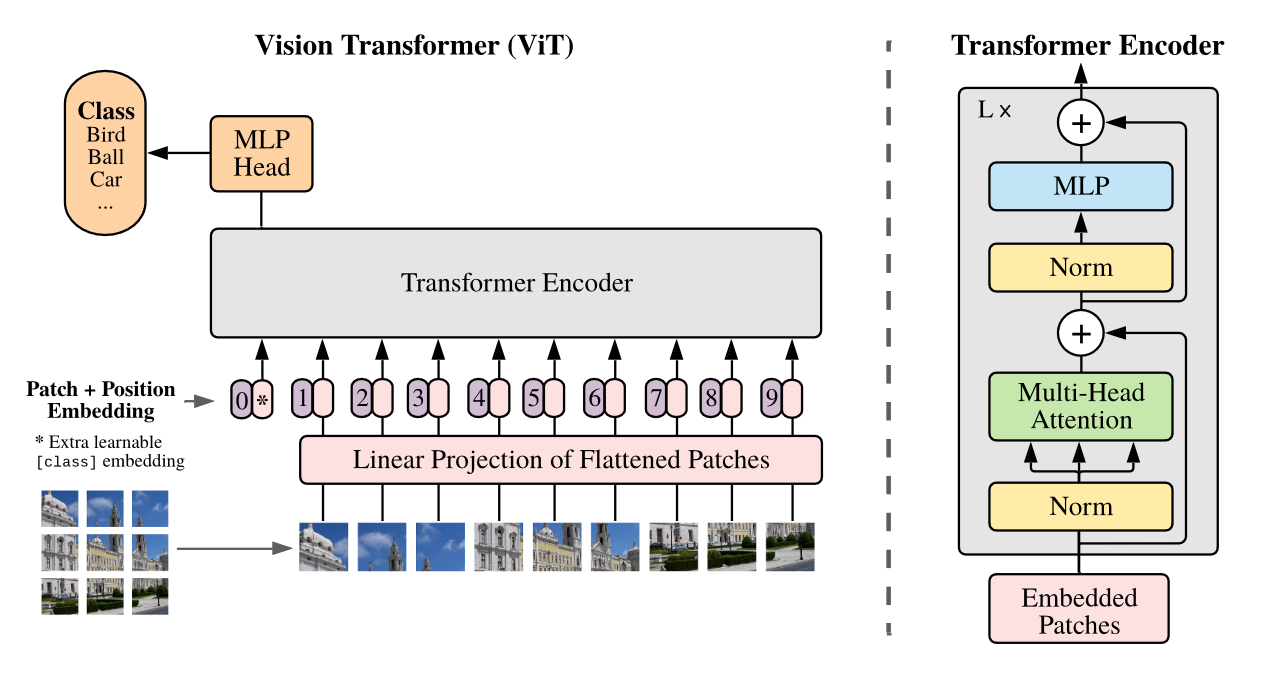
Model Architecture. Left: Image is split into fixed-size patches. Then each patch is applied linear mapping and add position embeddings. The resulting sequence of vectors are feed to a standard Transformer encoder. “0” and “*” are position 0 and learnable classification token.
ViT vs CNN
- CNN
- All conv layers have local inductive bias and are translationally invariant
- ViT
- Only MLP have local inductive bias and are translationally invariant
- All transformer blocks are global
- Positional embedding inject location information into each patch, hence transformer blocks are not translationally invariant
Resolution
- ViT can accept image with different resolution
- Patch size and linear project remains the same, but sequence length increase
- The pre-trained position embeddings may no longer be meaningful
- Requires 2D interpolation of the pre-trained position embeddings, according to their location in the original image
Experiments
- Datasets
- Pre-training
- ImageNet-1k: 1k classes and 1.3M images
- ImageNet-21k: 21k classes and 14M images
- JFT-300M: 18k classes and 303M high-resolution images
- Fine-tuning / Benchmark tasks
- ImageNet original validation labels
- ImageNet cleaned-up ReaL labels
- CIFAR-10/100
- Oxford-IIIT Pets
- Oxford Flowers-102
- 19-task VTAB classification suite: low-data transfer to diverse tasks
- Pre-training
- Models
- ViT-B: BERT Base architecture, 86M params
- ViT-L: BERT Large architecture, 307M params
- ViT-H: “Huge” model, 32 Layers, 1280 hidden size, 632M params
- ViT-L/16: “Large” variant with 16 x 16 input patch size
- CNN Baseline: ResNet / BiT
- Switch from BatchNorm to GroupNorm
- Standardized convolutions
- These changes improves model transfer
Results
- ViT-L/16, JFT-300M
- Outperforms BiT-L on all tasks
- Requires substantially less computational resources to train
- ViT-H/14, JFT-300M
- Further improves the performance
- Especially on ImageNet, CIFAR-100, and the VTAB suite

Comparison with SOTA on popular image classification benchmarks, averaged over three fine-tuning run. ViT models pre-trained on the JFT-300M dataset outperform ResNet-based baselines on all datasets, while taking substantially less computational resources to pre-train.
Ablation: Model vs Pre-training Size
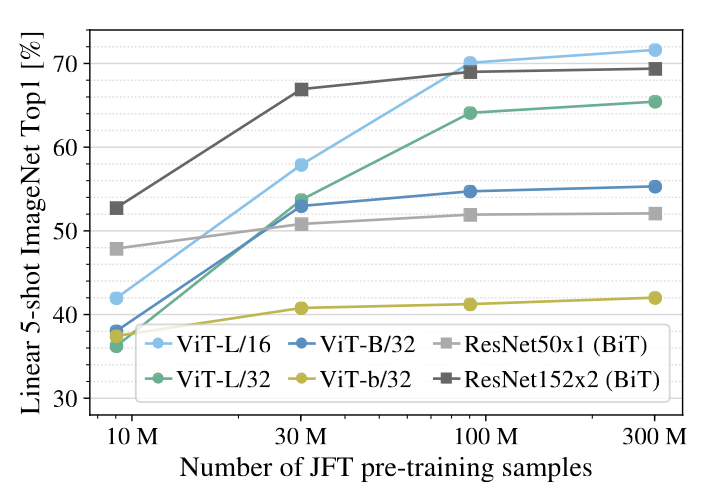
ResNets perform better with smaller pre-training datasets but plateau sooner than ViT, which performs better with larger pre-training. ViT-b is ViT-B with all hidden dimensions halved.
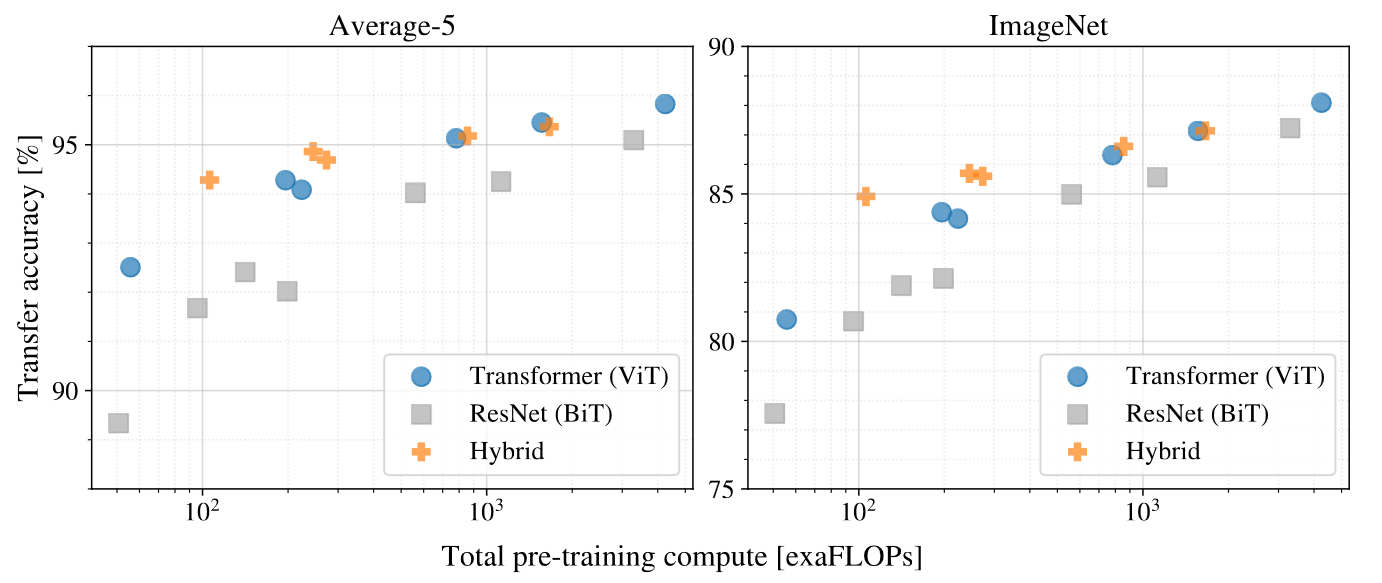
Performance versus pre-training compute. ViT uses approximately 2-4x less compute to attain the same performance.
Attention
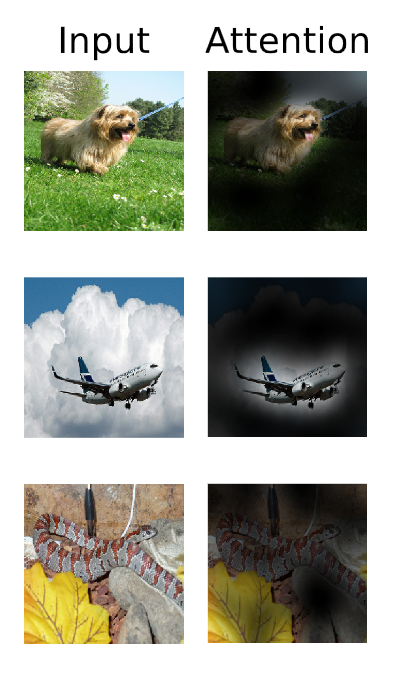
Attention from the output token to the input space, quantified by Attention Rollout. see Appendix D.8

Left: Filters of the initial linear embedding of RGB values of ViT-L/32. Center: Similarity of position embeddings of ViT-L/32. Right: Size of attended area by head and network depth. Each dot shows the mean attention distance across images for one of 16 heads at one layer. Attention distance: see Appendix D.7.
Limitations
- Requires label: self-supervised pre-training still underperforms supervised pre-training
DeiT
- Extensive ablation study on ViT training
- 86M params ViT trained on Imagenet-1k, with a single computer in <3 days
- ImageNet top-1 accuracy: vanilla=83.1%, distillation=85.2% (SOTA competitive)
- Distillation: Teacher-student strategy
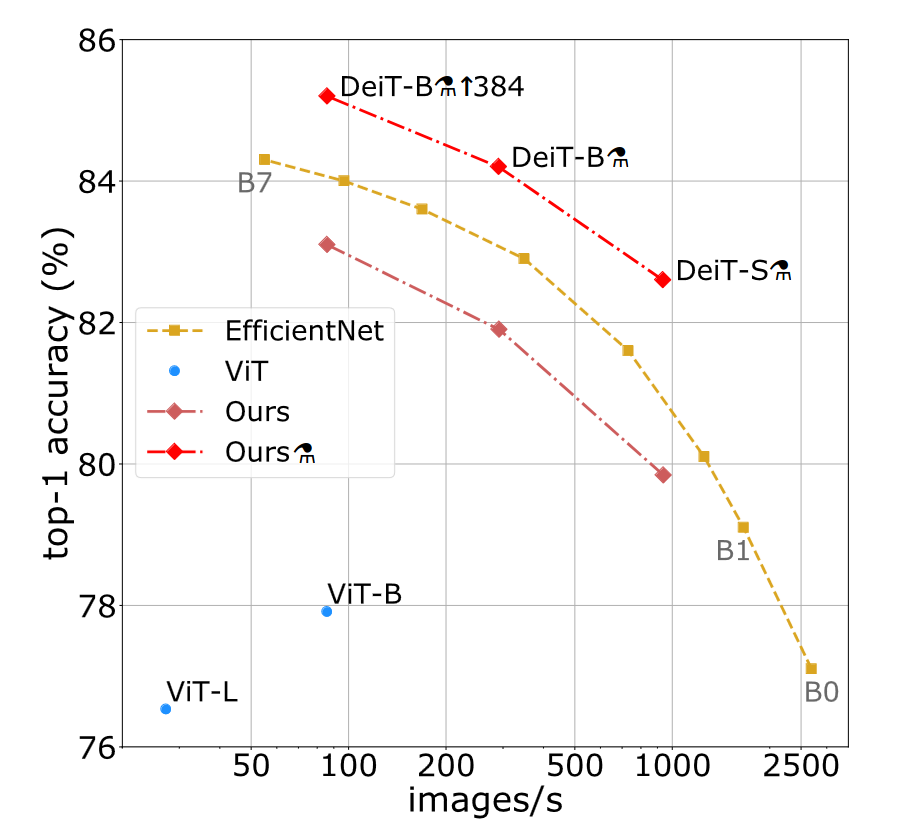
Throughput vs accuracy on Imagenet. Throughput is measured on 1 V100 GPU. DeiT-B and VIT-B has almost identical architecture, but DeiT-B is trained/optimized with a strategy for smaller dataset. The $m$ symbol represent distillation.
Background
- ViT paper: transformers “do not generalize well when trained on insufficient amounts of data”
- DeiT paper: generalization is possible with a medium size dataset, with correct hyper-parameters and repeated augmentation
- Knowledge Distillation (KD)
- Training of a student model leverages “soft” labels coming from a strong teacher network
- Hard label: class label
- Soft label: softmax vector over class label
- KD can be regarded as a form of compression of the teacher model
- KD can transfer inductive biases in a soft way
Overview
- DeiT-S and DeiT-Ti have fewer parameters and can be seen as the counterpart of ResNet-50 and ResNet-18
- The new distillation procedure is based on a distillation token, which plays the same role as the class token, except that it aims at reproducing the label estimated by the teacher
- With our distillation, image transformers learn more from a convnet than from another transformer with comparable performance
- SOTA competitive on transfer learning: CIFAR-10, CIFAR-100, Oxford-102 flowers, Stanford Cars and iNaturalist-18/19
Distillation through attention
- Requirement: access to a teacher model
- Ablations
- Trade-off between accuracy and image throughput
- Hard distillation vs soft distillation
- Classical distillation vs the distillation token
- Soft distillation
- Minimize the KL-divergence of the softmax between teacher and student model
- $L = (1-\lambda)L_{CE}(\psi(Z_s),y) + \lambda \tau^2 KL(\psi(Z_s/\tau), \psi(Z_t/\tau))$
- Where,
- $Z_s$ and $Z_t$ are logits of student and teacher model
- $L_{CE}$ is cross-entropy loss
- $\tau$ is distillation temperature
- $\lambda$ is balancing coefficient
- $y$ is ground truth label
- $\psi$ is softmax function
- Interpretation: global loss is balance between accuracy of student model (controlled by cross-entropy loss) and the student-teacher model difference (controlled by KL-divergence)
- Hard-label distillation
- $L = 0.5 \cdot L_{CE}(\psi(Z_s),y) + 0.5 \cdot L_{CE}(\psi(Z_s),y_t)$
- Where $y_t$ is teacher output label
- Interpretation: given the same image, $y_t$ may change depending on the data augmentation. This is advantageous when e.g., specific crop change the meaning of the image
Architecture
- DeiT: Original ViT + improvements included in the timm library
- Notations
- ViT-B = ViT-Base
- ViT-L = ViT-Large
- DeiT-Ti = DeiT-Tiny
- DeiT-S = DeiT-Small
- DeiT-B = ViT-B
- DeiT-$m$ = DeiT + distillation token
- Distillation token
- Interestingly, we observe that the learned class and distillation tokens converge towards different vectors
- The average cosine similarity between class and distillation tokens is only 0.06
- Distillation embedding
- Class and distillation embeddings gradually become more similar through the network
- Last layer similarity is high (cos=0.93)
- Ensemble learning
- DeiT can be viewed as the ensemble of two model: the class embedding model and the distillation embedding model
- Model size: see paper Table-1

Experiments
- Conv vs DeiT
- See paper Table-5
- Without distillation, DeiT outperforms ResNet of similar size, but still lag behind RegNetY and EfficientNet of similar size
- Teachers
- See paper Table-2
- The paper claims that Conv teachers generally outperforms DeiT teachers
- However, it appears that they didn’t compare different teachers on the same pretrain student network
- [1 Class token + 1 Distillation token on 2 loss head] performs better than [2 Class token on 2 loss head]
- Distillation methods
- See paper Table-3 (300 epochs) and Figure-3 (300-1000 epochs)
- Improved Training
- Hyper-parameters of ViT-B vs DeiT-B: See paper Table-9
- DeiT ablation: See paper Table-8
- Data augmentation have significant impact on DeiT performance
- Transformers are sensitive to initialization